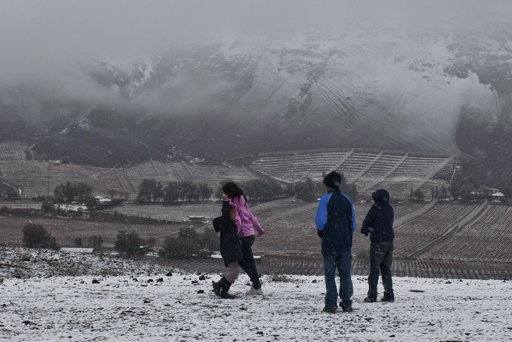
By Eva Vergara
This has been the wettest winter in decades for Chile's arid northern desert, where fractions of an inch of rain have done major damage in some areas and set the stage for spectacular floral displays in the weeks to come.
July came and went with major storms that together dumped more than five times the annual average of rain and snow on parts of the world's driest desert.
The past weekend's precipitation blocked highways, forced the cancellation of a top Chilean football match and damaged the homes of 1,800 people, said Vicente Nunez, chief of the Interior Ministry's national emergency office.
A similarly wet stretch in early July dumped four years' worth of rain in one day on coastal Antofogasta. That was just a quarter of an inch (more than 6.3 millimeters) but it was still enough to cause collapsed or leaking roofs in homes and businesses that usually have no reason to protect themselves against even minimal precipitation.
That storm also brought as much as three feet (a meter) of snow to mountains that normally receive zero precipitation during the southern winter. Soldiers helped rescue 400 people including busloads of foreign visitors who were trapped in snow drifts and 50 mph (80 kph) winds, said Ernesto Figueroa, chief of Chile's emergency agency in the northern Tarapaca region.
Some copper mines in the region, including the massive Collahuasi operation, temporarily halted production because of snowfall. Further south in Copiapo, dry riverbeds became torrents, trapping people who tried to drive across. The government helped out by delivering plastic sheeting to shantytown residents.
"Windstorms devastated some roofs and knocked over big trees," said Horacio Larrain, an archaeologist who lives in Iquique, where a dust storm surprised residents. "The sky was red with dust at sunset, which was something no one had ever seen before."
Average annual rainfall in the northern city of Arica is so low that it would take 50 years to accumulate an inch. This July, the city was swamped twice by what would be considered mild showers almost anywhere else on the planet. So far this year, Arica has had 0.13 inch (3.4 millimeters) of rain, more than six times its yearly average during 30 years of record keeping.
While climate scientists say global warming has made for increasingly extreme weather worldwide, this rain is particularly unusual for the Atacama, where precipitation has declined over the past century and climate change models predict deserts will expand southward and become even drier, said Juan Quintana, a meteorologist with Chile's weather service.
This year's rains and snow are caused by high-pressure systems farther south that have disrupted prevailing wind currents, Quintana said. From central Santiago southward, Chile is having a very dry year, causing drought conditions in places and draining reservoirs needed for hydroelectricity.
The Atacama desert ecosystem normally has very little vegetation or insects, and its flowers don't bloom every year. But July's rains should bring an amazing transformation, said Pilar Cereceda, a professor of biogeography at the University of Chile.
"We expect to have to have all these seeds and insects that are latent, that will explode. Probably we will find lots of flowers in many places," she said.
When the Atacama does bloom, purple and yellow flowers are most common, with spots of red, as an estimated 200 varieties of flowers burst from the sand. July's abnormal rainfall is expected to cause flowers to bloom starting in late August. Usually, the high season is September through November,
Tourism agencies are already preparing for an early influx of camera-snapping visitors, and environmentalists will be looking for evidence that the Dakar Rally, which now brings hundreds of off-road vehicles to the remote deserts each January, will have carved up tender bulbs and seeds that sometimes lay dormant for years just under the sand's surface, waiting for the next rain.
Article courtesy of yahoo.com

